Scarce Walther P.38: What Makes an Original Finish?
Patreons, this is for you
Hey guys! Today I'm going to do an educational video on a really rare P38. Before I get to that, however, I just wanted to let you know that I talked about doing some giveaways. This would be for our Patreons. Now, Patreons are those people who support the channel through YouTube. It's basically a YouTube program, they administer it. But those of you who are patreons, you support the channel, thank you very much. Because you really help to offset the cost of doing these videos and we really do appreciate it. So for those patreons, we're going to do a separate video. We're going to put your names in a hat, we're going to draw it out. These are some of the things that we're going to be giving away, we have some other things as well. So we'll give away maybe 10 or 12 items, and we will notify you if you won. So if you're a Patreon, stay tuned.
I got this at the Show of Shows
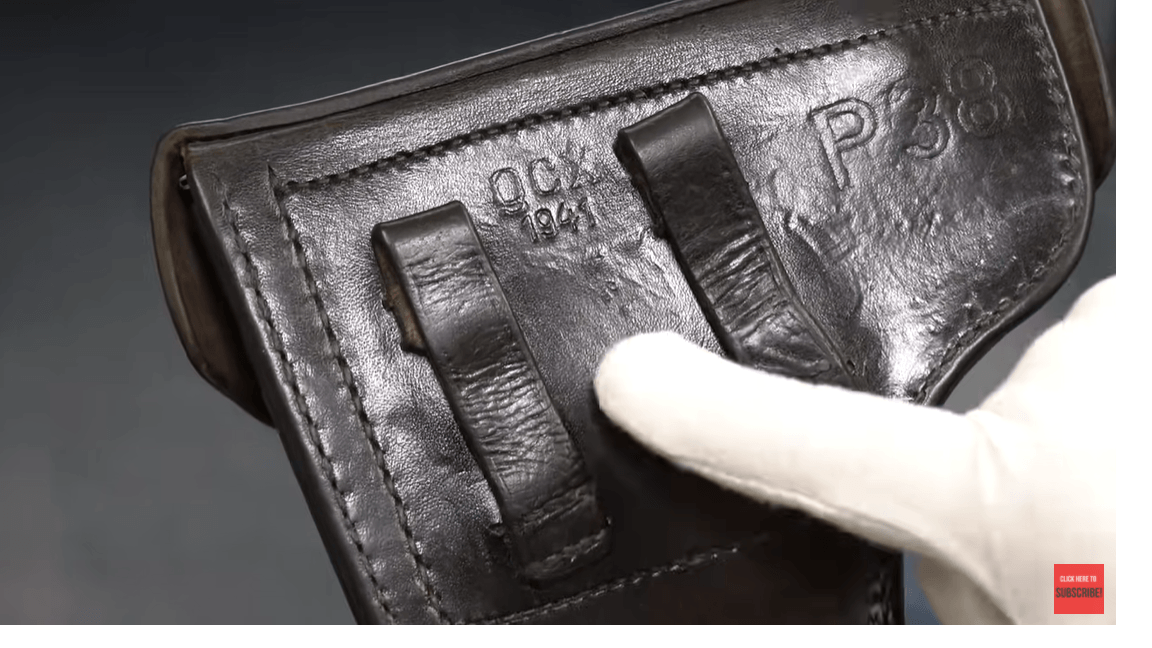
Now let's talk about this P38, which is the subject of today's video. I want to dissect it for you analyze it, we're going to learn a lot as we go through it and you may not be happy with my conclusion. But let's analyze it anyway. Let me come up closer and we'll take a look at the gun; we'll kind of unveil it for you. So I got this gun at the Show of Shows. I've been doing a couple videos and this is a standalone gun. You can see this is dated 1941. Although the gun you'll see is from 1940. There's just a part of a Waffen stamp but that was a hurried off center Waffen stamp. That's pretty typical, but it is there. And then it is mark P38. This holster is all original; stitching and everything is absolutely beautiful. They don't come much better than this. Inside, it's still pretty clean, and the spare magazine, we'll pull out because that's an important part of the story. I'm going to set this aside for now.
Drumroll Please!
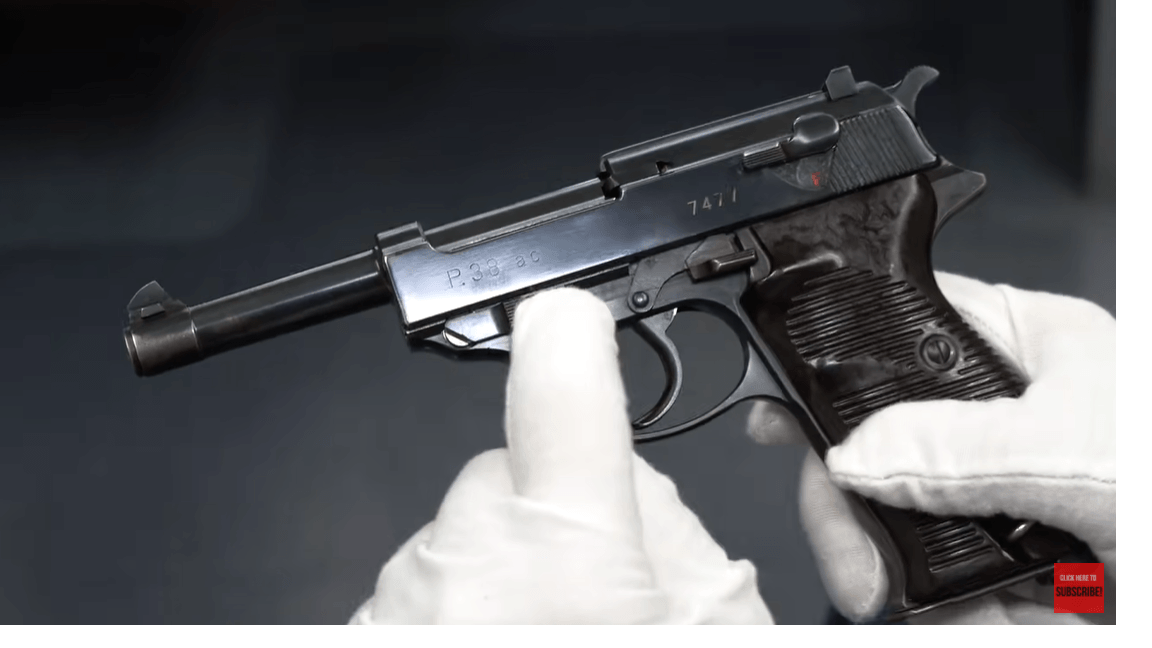
Okay, I feel like we should have a drumroll here but we'll just keep right on going. This is an AC, no date. The AC no date was exclusively made in 1940 and it only had a run of about 2500 guns. We'll be taking a look at the book in a minute. You do see the AC here as well, and then there is an AC on the barrel on the inside. We'll take a look at that when we take it apart.
Why dissect this gun?

The reason I wanted to dissect this is because these early AC 40s almost always went to the Eastern Front, because the Western Front really hadn't started yet. So they went to the Eastern Front and they were pretty well used and abused. So what makes this remarkable is this AC no date is in incredible condition. In fact, I would say this slide, that's absolutely beautiful. This sticks by the way a little bit, I put some oil on it, but it does stick a little bit. The S and the F are painted and that's still there. You do see wear on the front strap and we'll take a closer look at that. You do see wear on the barrel just like you would want to see. Both sides of the barrel you see wear, but this slide looks almost too good to be true. So that makes me wonder is it too good to be true? By the way this is dull, and this is a high polish finish. And that is correct. That was a dull because -- and I learned this from watching YouTube. When they cited the gun, they didn't want sun glare off of the high polish finish, so they made this a dull finish. So if you want to know if something is refinished, that's one of the areas you want to look at. And we're going to take a look at some more. But first let's go to the book and find out a little bit about the history of this gun.
Lets check with the P38 Pistols Book first

Okay, this is the book I'm going to be using. We do offer this on our website and I've used it before it is P38 Pistols by Alex Kutchek. You can see he has a 480 code featured right on the cover of the book. Also a very rare gun. Ours however, the AC no date, he has one here. Actually this is also very, very nice. I want to point out that the magazines are numbered on the side. In 1940, '41 and the beginning of '42, they numbered them on the bottom. However, the early guns which was the zero series, then the 480 code and just the first early run of AC 40s, they numbered them on the side. We see the serial range of the low to the high. We also see that they made about 2500 of these. Ours, by the way is 7477. So it goes right into the early range here.
The 480 Code
When I flip back a couple of pages you see the 480 code. Now the 480 code is a military model, it comes right after the zero series and these were issued obviously to the military in 1940. And the code for the factory was 480. Now you know about factory codes if you watch my channel - BYF for Mauser, AC for Walther; but you may not be aware that earlier 480 was the code for factory. And that only lasted for a very short period of time. You can see, they made about a little over 7000 of those.
Evolution to the ac Factory Code
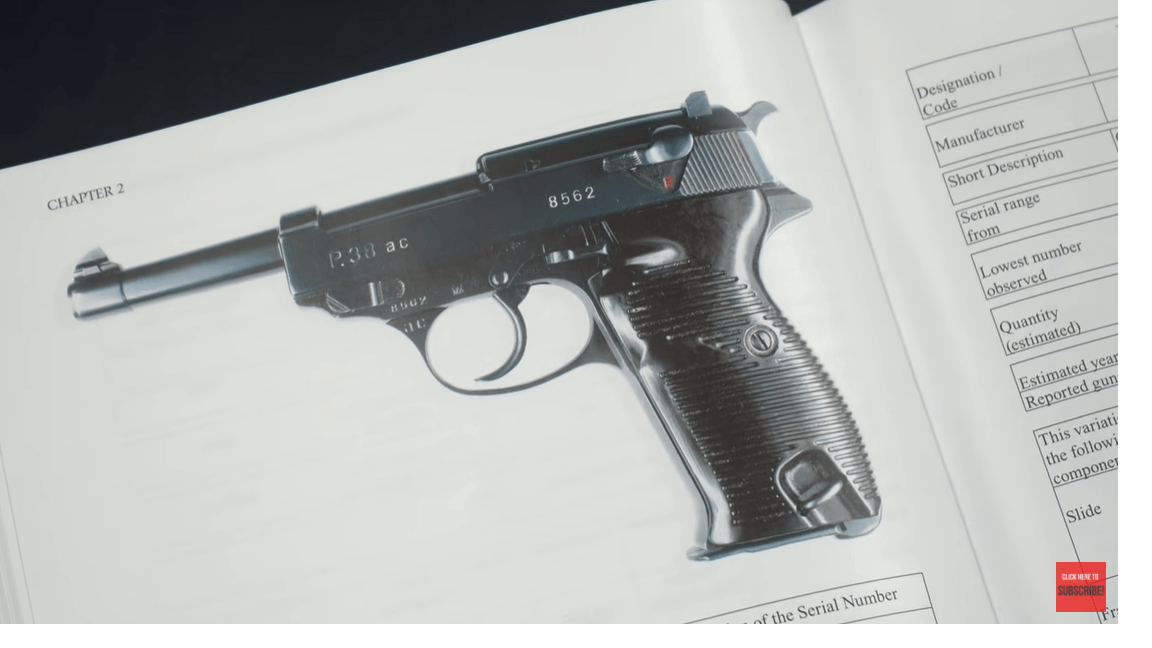
Fast forward, and we see that now they're using the AC factory code instead of 480 and that just means it was made in the Walther factory and they didn't put the date. But somebody in the factory who was really, really smart could foresee the future. And they knew that on our Legacy website, one of the most common questions we get is, when was my PP or PPK made? They always ask us that. I get it many times a day. Here's the serial number, when was my gun made? What we like about P38s is the date is right on there, so somebody really smart said, you know, this is going to be a problem down the road for Tom. So why don't we put a date on it. So after the first 2500 were made, and already shipped out the door, they said, let's add the 40. And from now on, we'll do AC 40, AC 41, 42, and so forth. So the next thing they did is the ones that were in the factory, they just literally added the 40. AC, and they added the 40. And that's known as the AC 40 added. And you see they made about 6000 of those.
Ac 40 not added

And then after that AC 40 you'll notice that was not roll stamped, they had to add it. Once they changed the roll stamp, then it was just part of the logo and I happen to have one. So let me show you an AC 40, that wasn't added. So this is the AC 40, that's part of the logo, not added. We've sold the AC 40 added; they sell for a little bit more money because they're a little bit more rare. But the rarest of all the military issued guns is the AC no date. So these bring a premium, they're highly sought after. And again, they only made about 2500. And this one comes with two matching magazines. The plus mark means this is the spare.
Literally unheard of
So an AC no date, with two matching magazines is literally unheard of. I've never seen one or heard of one. Also, if I quickly go back to the book, check this out, so exciting. We were 7477. This is listed by serial number as a known gun. Now they don't have any other information other than this was reported to the authors. And they included the serial number in the book.
The Magazines
Back to the magazines, there are two matching magazines, numbered on the side as I said. This is the AC 40 magazine, it is actually numbered on the bottom and that's the way they numbered them also in 1941. It's roll stamped on the bottom. And the Waffen stamps are two of them on the spine, one, two. And then in '41, they just Waffen stamped it once. There would be one stamp in 42 or after, few exceptions, and double stamped on the spine in 40 and 41. But for the very earliest ones, including the no date, they numbered them on the side. And these are two original matching mags with a double stamp at the bottom. Now if I take these off, and I think I will actually show you one of them -- take these off, each part is Waffen stamped inside and they didn't bother doing that later.
Let the dissection begin
Let's take one of these apart. The main reason I'm taking these apart is because this video is really about dissecting them, maybe too much minutiae. But on these early ones, that that's going to be an eagle 359 here, so the bottom of the floor plate, and then a Waffen stamp here. The spring, of course is not Waffen stamped it's just dirty. And here on the follower you also see the Waffen stamp. So all the internal parts other than the spring are Waffen stamped. And again, they stopped doing that in '41, they stopped Waffen proofing.
Under the Grips
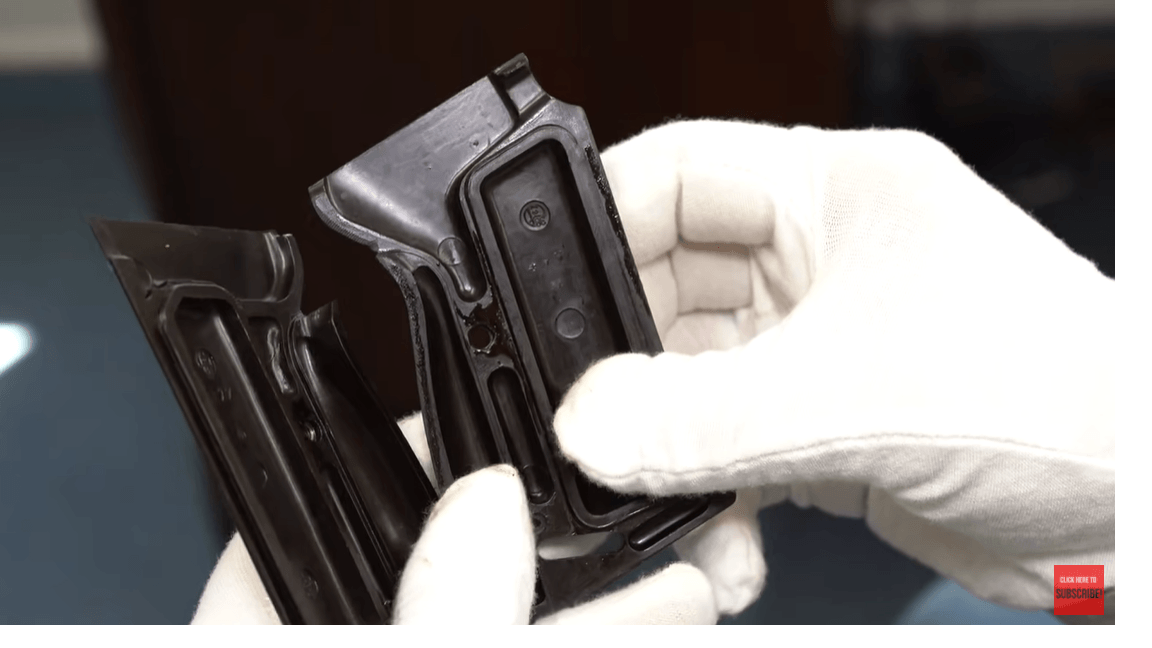
Let's take a look under the grips. Okay, I just pulled the grips off and these are numbered inside and again, they only numbered them, the zero series, the 480 code, AC 40s are numbered, but in '41 after the first letter block or so they stopped numbering them, however they did waffen stamp them. So both of them are Waffen stamped. You'll find them Waffen stamped all the way through to the end of '41 and maybe you'll see one or two early 42s that will have Waffen stamps. But they numbered them up until the end of 40. So these are matching grips to go with the two matching mags.
A close inspection to confirm an all original finish

Okay, so we've dissected a little bit, but the next most important thing is this all original finish. So as I was looking at this at the gun show, I could see that all of it looked to be completely original, but I was a little bit concerned about the slide. And first and foremost, when you are looking at a gun like this or you're at a show, it's important to have a bright light. I use this magnifying glass because I can look at the markings. But the bright light is important because you do want to see brown patina or rust under the blue. And sometimes it's very hard to spot, but there's key areas where you would expect to see more rust. One would be the front strap, and you can certainly see brown patina. Now when I turn the light off, it just looks blued, maybe a little bit of patina. But when I turn the light on, you do see the brown patina and that tells me that this frame is original finish. Again, that's where your hand goes. The other place that people don't think of is where the web of your thumb always hits up in here. And so this is an important area to check right up in there. And you can definitely see the brown patina here. Top plate, you see brown patina, and it is dull, it is Waffen stamped all the small parts are Waffen stamped. You see that Waffen stamp here, you'll see the Waffen stamp right here on the slide stomp, and a Waffen stamp under here - that's the takedown lever, on the hammer you see the Waffen stamp. If I take this all apart, there will be Waffen stamps on the internal parts, firing pin and and also let's see, trigger, barely visible right up there, there is a Waffen stamp. So again, internal and external, all of these parts are Waffen stamped, just like the magazine.
Barrel check

Let's look at the barrel. I see brown patina through here. And also we'll take a look at the barrel; but I can see brown patina, it's actually really, really nice. And I do see brown patina on the barrel. And you see significant wear around the muzzle. So I would say the barrel is also all original. One other area that's very important to check. When I'm at a gun show, of course, you got to get permission to really mess with the gun. But something like this can easily be $15,000 - $20,000. You see on the barrel, the ring around the entrance or the ramp to the barrel is in the white. And that is correct. Also want a gun this nice, of course you want to check the bore, and I'm not good at getting bore shots. I like getting bore shorts, but the bore shots are a little harder. It's not mint, it's got a little bit of cloudiness to it, but it is shiny with strong rifling.
The Slide
So the only remaining issue then is the slide. And that's the part that I had questions about. Again, it looks almost too good to be true. You do see a little bit of wear on the end here, you'll notice the red and the white, the white looks a little bit aged. Although somebody added wax pencil, I don't know when, but somebody added wax pencil to this. I don't see patina on the slide. And let's check over here. This is an important fact. First of all, on these early guns, they would have what they called a drip mark. And that had to do with the bluing process. I've heard theories about it. But basically, the drip mark is barely visible right here. I do see a faint drip mark. And then also the first stamp is under the blue. So before they blued the gun, they Waffen stamped it. Basically, it's a Waffen proof, meaning this was inspected and passed. And then the next two are in the white, meaning overtop of the blue. And that's certainly the case here.
Did they reapply the stamps?

So if this slide is not original, then somebody had to reapply those stamps. And that's what I'm trying to figure out. Did somebody reapply these stamps or is this really this nice? Let's take a look at a couple other guns to compare it to.
Let's do a comparison
This is a zero series, it has the Walther banner, there's no factory code because again, the 480 was used after that, but this one they just brazenly put the Walther banner on there. And this is actually a second variation zero series, which means it's going to have a rectangular firing pin. And sure enough, it does. But that's not what we're here to talk about. And this is not a good example to show you but this is a cautionary tale.
Cautionary Tale
When you're at a gun show and you're not sure a lot of times when you've got something to hide, people put the white wax pencil on that and now I can't tell if that is under the blue or over the blue. So just a caution. This doesn't mean it was refinished. In fact, this was not refinished, you can see the gun has plenty of wear, the slide has plenty of wear. And also see the drip mark on that one. It's very faint, but it's there. But because they put the white wax pencil in there, I can't tell. So if I'm at a show I, it's almost impossible to get them to remove that. So if it's in question that's not very helpful at all.
Another comparison, third variation zero series
But here's another zero series, a little bit later. A third variation zero series. This one, they happen to paint the front sight and the back sight, and they did that in the factory when requested, but not always, obviously. So there's a zero series. Let's take a look at a couple of things we've already looked at. Notice the feed ramp there, it's in the white, we've already looked at that. Notice patina; notice here, the first stamp is blued over -- have to hit the right angle on that. And then the next two are overtop of the finish. And you also see the drip mark. Very little patina on the front strap. This is just a beautiful zero series. Still not of nice high polish finish, let's look under here. Definitely you can see a little patina under there, a little bit of brown. See some brown through here. So this one we know is all original finish. And you can see how the proof marks look.
Side-by-side Comparison
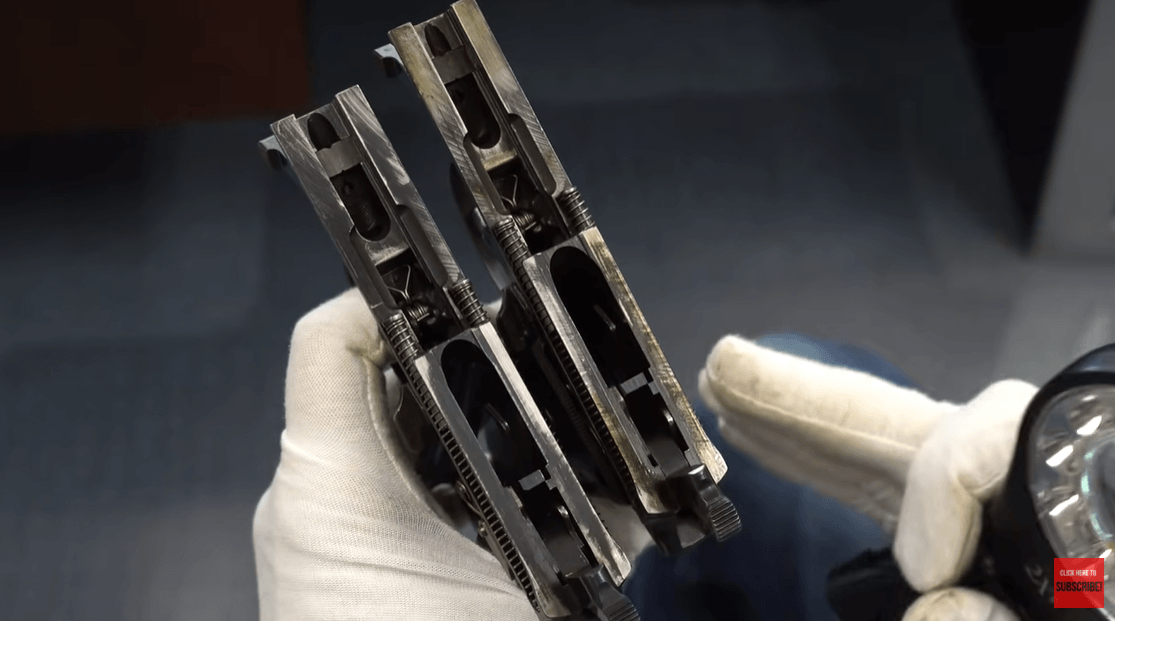
Since this is the closest example let's take this one apart and compare them side by side. So these are the two frames side by side. The one on my right is the zero series. And this is the AC no date. If the frame has been redone, and I already said, I'm sure the frame has not been redone, they'll always take these springs off when they refinish the gun. So these are almost always in the way, These springs, you can see. But the one area that they don't get is the trigger spring down inside there, let's shine a light. And I would expect both of them to be in the white. And sure enough, they are. So you want to take a look at the trigger spring. If you're in a gun show shine a light down in there. If they are blued, then that means the gun was refinished. So as expected, both of those are in the white. And you can see that this was blued, these rails were blued but with wear they begin to become shiny again, and that's exactly how it should look.
Not refinished, but Russian Dipped
Now I don't have a refinished gun, but I do have a Russian dip gun. So let me just show you a comparison on one that we know was dipped. So this is the AC no date, this is actually a Russian Dipped CYQ. A lot of the CYQs are Russian dipped because the Russians occupied the factory at the end of the war and occupied that territory for a period of time. So here you can see the difference. Now there's a lot more dirt and grease inside here, but you can see that these springs are in the white but the trigger spring is dark. Compared to in the white and dark. So that tells me this was either refinished or Russian dipped.
Russian Dipped vs No Date
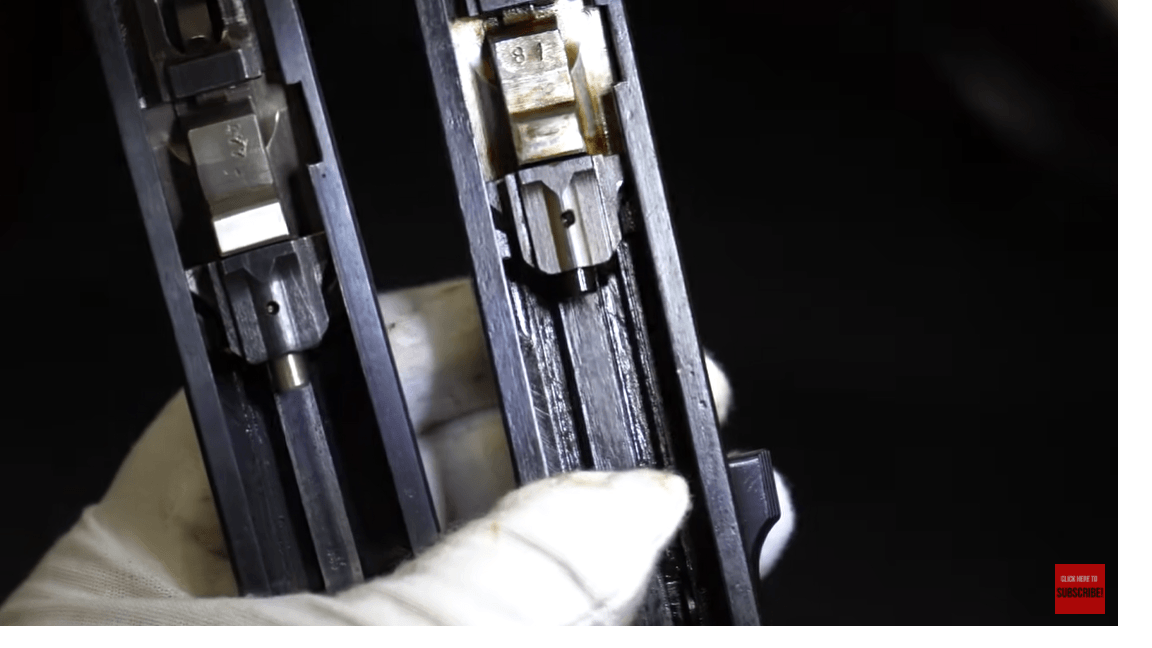
So here's the upper of the Russian dipped gun compared to the no date. And I want to show you this because usually on a gun that's been refinished, the locking block will also be blued. But I want to give you a little cautionary tale about the fact that this locking block pops right out, it's dirty. So all I have to do is push back and that locking block pops right out. So if this was Russian dippped, this locking block should be dark, but in fact, you can see it's been cleaned off. So basically, when people refinish guns, they often will clean off the locking block, because that's really easy to do. The springs are in the white because that's easy, but I mentioned the trigger spring is harder and also just notice this. This pin is dark. So the pin should be in the white. If you see the locking block clean -- the pin is very hard to take out, whereas the locking block is easy. So again, if you're looking at your gun and you have a clean locking block but the pin is dark, then the gun has had something done to it. Now it's not 100% but it's certainly on the early guns, the pin should be in the white. Later on, they did rework parts and things so it's not the kiss of death, but it is a caution that you should have. If this is dark, then this gun has been altered in some way. And in this case it was Russian dipped and then cleaned up afterwards to make it look better.
Final Inspection of the No Date

So let's take our final look at the no date. And again, I'm still in a quandary, because if you heard me, there's some things I like about it. This looks all correct. If I take this off, this is in the white, I've already discussed that. The bore is not perfect, but certainly looks original and passable for a beautiful gun that's not been shot a whole lot. Another clue that you want to look at is where it hits the striker that should show wear and it does. Again, comparison, this is my Russian dipped gun. And if a refinished gun even more, this had a few strikes on it, but you can see how dark it is compared to what it should look like. For a very nice looking gun just has wear on the striker from the hammer hitting the striker. While I have the barrel off, I can go ahead and show you that the serial number is on the barrel and matching. And also you want to check the locking block because it'll have the last three digits on it, and it does. It also will be test proofed. Here there's a Waffen proof on a locking block. There's a Waffen proof here on the barrel. And some other inspector proofs on the locking block. You also see right here one more test eagle. I'm convinced this is all original and correct.
I'm back to the slide

So once again, that just brings us back to the slide. Here you see a Waffen stamp inside the slide and that looks all original. And the only thing that I had questions about was was this redone? And I said early on, I hope you really learned something by going through all of this, but you're probably not going to like my conclusion. My conclusion is I can't say for sure. This just looks a little too good. It's all correct. If somebody redid this slide, they redid the stamps, and they truly were a professional. I've mentioned this before, but in the cold world do you think of a Turnbull restoration, they often will sell for as much if not more than an all original one, because they are done so professionally well. I mean, you can't tell the difference between the original and the professionally restored. If anything on this gun was restored, it was this slide. And that's only because I have a gut sense, it's just too good to be true. But is that absolutely stunningly beautiful. If it was your gun, I would be I'd be very hesitant to tell you there was something wrong with it. If it was your gun and you said what do you think? I would probably tell you I like it a lot. Since it's my gun, I will tell you I'm not 100% sure. Even as I'm doing this video, I'm struggling. I'm going to go 60:40, 60% it's all original, 40% this slide has been redone. So it's a really good exercise to go through to examine all the parts. And if you're ever interested in buying a gun this nice and this expensive, this rare, you really want to get checked out by an expert before you pull out your wallet.
Can I put this back together?
So here I sit with all my dissected parts. I feel like the kid in high school that dissected the frog and he gets all the parts laid out and it's like, oh now what do I do? I hope I can get this back together. Hey, thanks for watching. I hope you learned something today and make sure you like and subscribe to our channel and for you Patreons, don't forget we got some free giveaways coming right at you.
